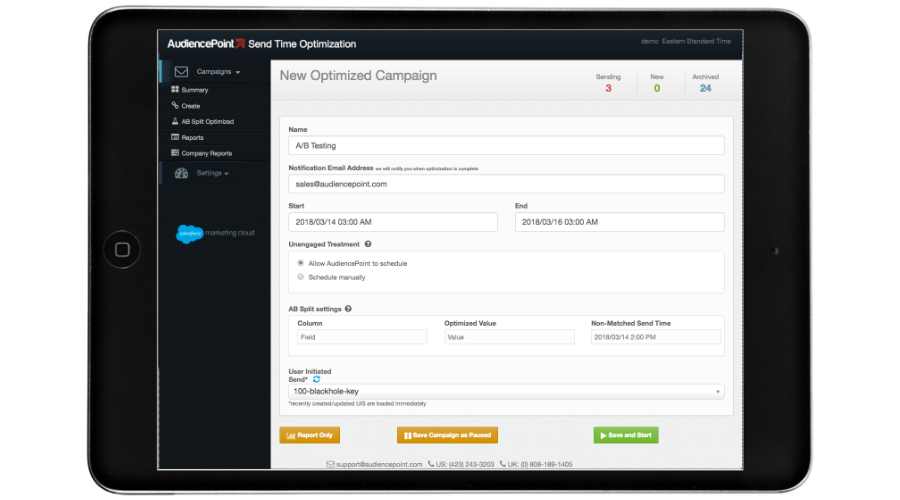AudiencePoint is thrilled to announce our new integration with Klaviyo! AudiencePoint is looking for partners to pilot our...
What Is The 3 Email Rule?
The 3 email rule in email marketing is a strategic approach intended to optimize the delivery and reception of marketing emails. This rule suggests that sending no more than three emails to your subscribers within a short period (such as a week) can help maintain their engagement and minimize opt-outs. The idea is to balance frequency with relevance, ensuring that your audience receives valuable and timely content without feeling overwhelmed or spammed.
Email Marketing Trends in 2025
As email marketing evolves, new trends in 2025 are shaping how marketers implement strategies like the 3 email rule. Trends such as increased personalization, automation, and advanced segmentation are making it easier to send targeted, relevant emails while maintaining the ideal balance of frequency and engagement.
Timing and frequency play crucial roles in successful email marketing campaigns. With the 3 email rule, marketers can strategically plan their communications to ensure maximum email engagement. This entails designing a sequence of emails that build on each other, and delivering coordinated messages that guide subscribers through various aspects of a campaign. By doing so, marketers can enhance brand recall while preventing subscriber fatigue, which often leads to unsubscriptions or emails ending up in spam folders.
Impact Of The 3 Email Rule On Inbox Placement
Adhering to the 3 email rule can significantly impact your inbox placement. Email providers and spam filters are more likely to reward consistent, spaced-out, and meaningful communications with favorable placement. This reduces the risk of your emails being flagged as spam due to an overly aggressive sending pattern. Leveraging tools like AudiencePoint can provide further insight into optimal sending strategies tailored to your audience’s behavior, ensuring your messages reach their intended inboxes.
The Balance Between Quality And Quantity
For marketers, finding the right balance between the number and quality of emails sent is critical. While it might be tempting to overload your audience with information, prudence suggests focusing on email content that truly resonates. Adhering to the 3 email rule aids in striking this balance, allowing engagements that are both substantial and insightful. This practice not only improves email deliverability but also strengthens your brand’s reputation.
The Role Of Audience Segmentation
Employing audience segmentation can enhance the effectiveness of the 3 email rule. By segmenting your audience based on various criteria such as past purchases, engagement history, and demographics, you can customize your messaging to suit different segments. This ensures that each set of three emails sent is relevant and catered specifically to the interests and needs of the recipients, further enhancing effectiveness and reducing the chance of emails landing in spam folders.
If you’re interested in learning more about “Email List Segmentation Benefits” read our blog!
Understanding The Inbox Placement Test
The inbox placement test is a valuable tool in email marketing, used to ascertain whether your emails are landing in your recipient’s inbox, promotions folder, or, worse, the spam folder. While a delivery rate merely tells you that an email reached the recipient’s server, an inbox placement test dives deeper, revealing where exactly your email is positioned once delivered. Understanding this positioning helps marketers fine-tune their email strategies to improve visibility and engagement.
Conducting an inbox placement test traditionally involves sending a batch of emails to test email accounts set up across multiple service providers. This simulation allows marketers to examine where those emails land, equipping them with insights needed to make rational improvements in their campaigns. It ensures that your strategic efforts in email crafting are not in vain by confirming they reach the intended viewing location for potent engagement.
Technical Aspects: SPF, DKIM, And DMARC Authentication
Key to a successful inbox placement test is three core protocols: SPF (Sender Policy Framework), DKIM (DomainKeys Identified Mail), and DMARC (Domain-based Message Authentication, Reporting, and Conformance). These technologies play an integral role in your email authentication strategy, signaling to internet service providers that your emails are legitimate and protected from spam tactics.
SPF operates by validating the sending mail server, ensuring it’s permitted to send emails on behalf of your domain. DKIM adds a cryptographic signature to your emails, further verifying their authenticity. Meanwhile, DMARC provides the overarching strategy that instructs receiving email servers on what to do with messages that fail SPF and DKIM checks. Employing these authentications is a technical imperative for any marketer aiming to enhance their inbox placement.
Benefits Of Conducting Regular Inbox Placement Tests
Regular inbox placement tests offer substantial benefits, vital for maintaining a high standard of email marketing. These tests enable marketers to track improvements or declines in placement rate, diagnosing potential issues early. By systematically verifying that emails reach the main inbox, marketers can safeguard their sender reputation and ensure steady engagement.
AudiencePoint offers a sophisticated suite of tools, cutting through the complexities of email marketing metrics to provide you with actionable insights. Through advanced engagement analytics, our solutions empower you to optimize inbox placement continuously. With these insights, marketers can refine their strategies, ensuring emails not only reach the inbox but resonate effectively with recipients. Enhancing email optimization, facilitated by ongoing testing, ultimately leads to improved opens, clicks, and conversion rates.
Decoding The Inbox Placement Rate
The inbox placement rate is a crucial metric in email marketing, as it measures the percentage of emails that make it to the recipient’s inbox as opposed to the spam or junk folders. While the delivery rate reflects the number of emails accepted by the recipient’s server, the inbox placement rate provides a deeper understanding by focusing on the quality and relevance of the email content, as determined by the recipient’s email service provider.
Explanation Of Inbox Placement Rate Versus Delivery Rate
The delivery rate indicates emails received by a server, but not necessarily emails seen by recipients. In contrast, the inbox placement rate confirms that emails successfully land in the inbox rather than ending up in a spam folder. A high inbox placement rate showcases how well your emails are perceived and can directly affect open and engagement rates. This metric is a more accurate indicator of your campaign’s performance and efficiency in reaching the audience genuinely.
Significance Of Maintaining High Inbox Placement Rates
Maintaining high inbox placement rates is vital for any successful email marketing strategy, as they are directly correlated with increased visibility and engagement. Emails placed in the primary inbox are more likely to be noticed and opened, which enhances opportunities for engagement and conversion. This not only improves the return on investment (ROI) for your campaigns but also strengthens your brand reputation and trust with email service providers, minimizing the risk of future emails being marked as spam.
Impact Of Engagement And Content On Inbox Placement Rate
Engagement and content are pivotal in influencing your inbox placement rate. Personalized and relevant content that resonates with your audience increases engagement and positively impacts the perception of your emails by email service providers. This improves the likelihood of landing in the primary inbox. Regularly updating your subscriber lists and segmenting based on interest ensures that the right message reaches the right audience, ultimately boosting engagement and fostering higher placement rates.
Partnering with tools like AudiencePoint can give email marketers the upper hand by providing invaluable insights into how campaigns are performing in real time, allowing for immediate adjustments to improve results.
Conclusion And Best Practices
In conclusion, understanding and enhancing email inbox placement is crucial for the success of any email marketing strategy. The distinction between inbox placement and deliverability underscores the importance of making sure your emails don’t just reach the recipients’ mail servers but also successfully land in their inboxes, not the spam folder. This requires a holistic approach that combines strategy, technology, and knowledge of your audience’s preferences and behaviors.
Best Practices For Improving Inbox Placement
Adopting some proven email best practices can markedly enhance your inbox placement rates. First, ensure your email content is relevant, engaging, and personalized to captivate your audience and trigger positive engagement. Practicing effective list management by regularly cleaning your list of unengaged or invalid emails can drastically improve your sender reputation.
Incorporate robust reporting and analysis to monitor your campaigns and adjust strategies for improved inbox placement. Technology advancements have made it easier for marketers to gain unprecedented insights into subscriber behaviors, enabling more precise targeting and content relevancy.
To read more about “What is the average inbox placement rate?” read our blog!
Final Recommendations For Effective Email Marketing
For an optimized email strategy, focus on consistent testing and monitoring to adapt quickly to any shifts in engagement metrics or inbox algorithms. Leveraging advanced tools can provide comprehensive insights into your subscriber base. This not only aids in pinpointing at-risk email addresses but also refines your overall marketing efforts.
Discover how AudiencePoint’s advanced tools can unlock unparalleled insights into subscriber behavior and optimize your campaigns for peak performance. Increase engagement, perfect list management, and pave the way to unmatched email marketing success with AudiencePoint by your side. Transform your approach to email marketing and ensure your messages always reach and resonate with your audience.





